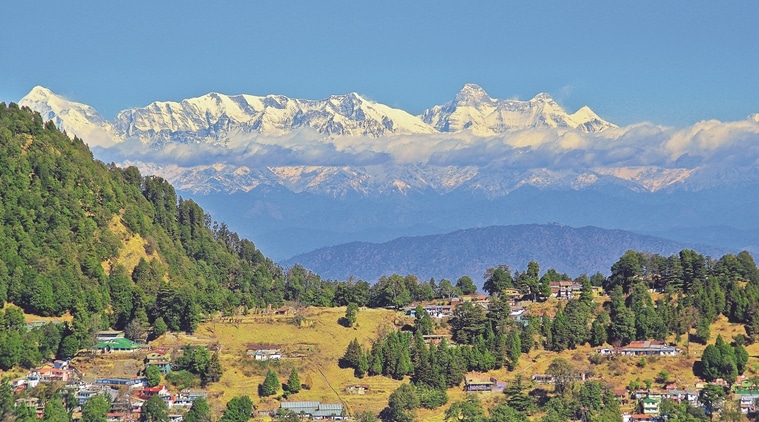High on a Mountain Top: When you get out of the city, nature welcomes you with wide open arms
The mountains, they fool you every time. You stare up at the pristine blue sky and suddenly realise that what you thought were clouds riding high are actually the great Himalayas.
 You stare up at the pristine blue sky and realise that what you thought were clouds riding high are actually the great Himalayas, floating majestically in the middle of the sky
You stare up at the pristine blue sky and realise that what you thought were clouds riding high are actually the great Himalayas, floating majestically in the middle of the sky
It happens every time: Five minutes into the mountains, and you’re wondering (and berating yourself as to) why the heck you live in a city. Here, every sense seems suddenly electrified and yet laidback at the same time. The forests, be they of pine, fir, deodar or mixed, stand tall, dark and handsome on the precipitous slopes, guarding silent secrets hundreds of years old. Your eyes are peeled and your ears cocked. Arrive early and you’ll hear an assorted chorus of squawks, whistles, squeaks and even catcalls from the woods as the unseen birds greet the new day.
The mountains, they fool you every time. You stare up at the pristine blue sky and suddenly realise that what you thought were clouds riding high are actually the great Himalayas, floating majestically in the middle of the sky, the sun honing their glassy ridges like knife blades. The birds and animals that dwell in this mountainside wild garden at Sonapani are shy, and sensibly don’t give up their privacy easily. Birds flit restlessly — as if they have some twitchy obsessive compulsive disorder — in the thick glossy foliage, giving you tantalising glimpses of flashy scarlets or brilliant yellows or ultramarine blues before vanishing in a whirr of wings. But you can get lucky if you come across a feeding party coursing through the trees — a bit too lucky perhaps, because they can make you hyperventilate and not know what to focus on.
As always, secrets are revealed slowly. You soon realise that those familiar little birds of Delhi, the white-eyes are doing very well here too, as you hear their soft musical jingling nearly everywhere. The busy squeaking black-headed tits, like miniature gangsters, come and go and zip around restlessly, the neat great tits and yellow-breasted greenfinches (looking like they badly need a wash) cling to stalks as they clean up seeds, and that old friend — the streaked laughing thrush in russet corduroy — scuttles mouse-like between the flower beds and great stands of golden rod. That neat yellow and silver-grey warbler with its sharp needle call, the grey-hooded warbler is ubiquitous. A sudden hullabaloo signals a gang of raffish white-throated laughing thrushes, snazzy in their gangster masks and full of joie de vivre. Far away, from across the valley, that mad bird of the mountains — the great barbet — yells manically. A falcon (shaheen?) folds its wings and lands on a pine I have christened the lollipop pine because of the way it has been lopped. (Lopped lollipop!), and from here too, when the coast is clear, a black partridge, decked to the nines in gold, copper, ebony and white, stands on tiptoe and sends out its call across the valley. Spotted doves croon like purring cats, who no doubt would like to avenge the insult! Stay awhile and the black-headed jay may saunter into your verandah for a quick chhota hazri of moths.
Even so, it takes work to winkle out the birds. The insects whirr and buzz everywhere and are easier to observe (sometimes in places you would prefer not to encounter them). My first act every morning was to look at the moths that had come dizzy-dancing the night before to the verandah light outside the room and slept over. Silvery white, black, bronze, orange, yellow, beige, adorned with tapestry like patterns, and wings shaped like those of stealth aircraft and alien spacecraft. But staying over too can be dangerous — grey tits and Himalayan bulbuls, for example, have figured out that they can get a pretty good breakfast by snacking on hungover moths. Butterflies flit and chase each other, tap dancing on cosmos, dahlia and buddleia or soaking up the sun and minerals from the earth — and horse dung. Huge lady wood spiders string webs as large as fishing nets between the trees, and hang hopefully there, with various silk-wrapped meals surrounding them as well as a couple of hopeful puny gentlemen suitors lurking at the edges.
After dark, the night shift takes over, a nonstop shrill orchestra comprising frogs and crickets et al. One musician stands out, sounding like a garden sprinkler whizzing round and round, spurting jets of water as it goes past. In the distance, a scops owl, perhaps, emits its sharp metallic call at precisely timed intervals. During the rains, metallic black rhinoceros beetles (accompanied by their hissing wives) lumber out for constitutionals from their holes, and squat grey toads flop like flaccid water balloons as they attempt to negotiate steps.
As for the larger mammals, you need to be lucky to see them: barking deer hastening through the gullies, langurs crashing through the overhead canopies and once — elsewhere in these mountains — a pair of yellow-throated martens scurrying along the eaves. There are, of course, leopards a-plenty — they say the average life expectancy of dogs here is four to five years because “leopards too have to eat.”
A word of warning: while returning from such an idyllic sojourn, creep back into the city by train at night or before daylight. Never take a day flight in for you will be scared witless as your aircraft descends into the murky grey-brown fug that smothers the city.
But who asked you to return anyway?
Ranjit Lal is an author, environmentalist and birdwatcher





- 01
- 02
- 03
- 04
- 05






















